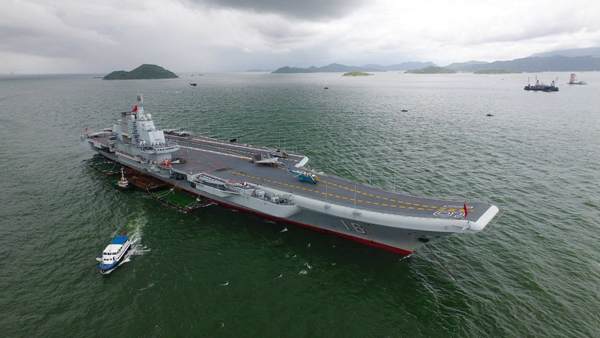


File photo of CNS Liaoning, China's first carrier. [Photo/Xinhua]
The builder of the Navy's aircraft carriers has become able to make new, larger carriers, according to its chairman.
Liu Zheng, chairman of Dalian Shipbuilding Industry in Liaoning province, said his company and its parent, China Shipbuilding Industry Corp, the world's largest shipbuilder, have acquired the ability to design and build aircraft carriers-the most technologically sophisticated of all surface vessels.
Their capabilities have been gained through construction of the CNS Liaoning, China's first carrier, which was built based on a half-finished, imported Soviet-era vessel, and the nation's first domestically designed carrier, which is in the final outfitting stage before starting sea trials.
"We have complete ownership of the expertise, in terms of design, technology, technique, manufacturing and project management, that is needed to make an advanced carrier," he said. "We are ready to build larger ones."
Liu spoke to China Daily on Wednesday as he arrived in Beijing to take part in the coming first session of the 13th National People's Congress as a deputy from Liaoning province.
The People's Liberation Army Navy operates the Liaoning, the sole aircraft carrier, which received an extensive refit at the Dalian shipyard before going into service in September 2012.
The Liaoning carrier battle group has completed several long-distance training operations and cross-sea, live-fire exercises. Dozens of pilots and landing signal officers have become qualified to operate the J-15 carrier-borne fighter jet aboard the carrier, according to the Navy.
Construction of the nation's second-and first indigenously designed-carrier began in November 2013. It was launched in April and will start sea trials soon.
Once completed, the gigantic ship will have a displacement of at least 50,000 metric tons and a conventional propulsion system, and will carry J-15 fighter jets and other carrier-borne aircraft. Like the Liaoning, the ship will use a raised, "ski jump" deck for launching fixed-wing aircraft.
The new carrier's name and hull code remain unknown. The Navy usually makes public such information when a ship is commissioned.
Several aspects distinguish the new carrier from the Liaoning, according to the Navy. The new carrier has more space to accommodate fighter jets; its superstructure is shorter; it has better radar; the landing section is longer, and its air command bridge is larger.
Xiao Ning, editor-in-chief of Weapon magazine, said that the second carrier will have different missions than those of the Liaoning, which is mainly tasked with testing equipment and weapons and training personnel. The new vessel will focus on duties for which most carriers are built: running combat-ready patrols and safeguarding the nation's maritime sovereignty and interests.
 Fire brigade in Shanghai holds group wedding
Fire brigade in Shanghai holds group wedding Tourists enjoy ice sculptures in Datan Town, north China
Tourists enjoy ice sculptures in Datan Town, north China Sunset scenery of Dayan Pagoda in Xi'an
Sunset scenery of Dayan Pagoda in Xi'an Tourists have fun at scenic spot in Nanlong Town, NW China
Tourists have fun at scenic spot in Nanlong Town, NW China Harbin attracts tourists by making best use of ice in winter
Harbin attracts tourists by making best use of ice in winter In pics: FIS Alpine Ski Women's World Cup Slalom
In pics: FIS Alpine Ski Women's World Cup Slalom Black-necked cranes rest at reservoir in Lhunzhub County, Lhasa
Black-necked cranes rest at reservoir in Lhunzhub County, Lhasa China's FAST telescope will be available to foreign scientists in April
China's FAST telescope will be available to foreign scientists in April "She power" plays indispensable role in poverty alleviation
"She power" plays indispensable role in poverty alleviation Top 10 world news events of People's Daily in 2020
Top 10 world news events of People's Daily in 2020 Top 10 China news events of People's Daily in 2020
Top 10 China news events of People's Daily in 2020 Top 10 media buzzwords of 2020
Top 10 media buzzwords of 2020 Year-ender:10 major tourism stories of 2020
Year-ender:10 major tourism stories of 2020 No interference in Venezuelan issues
No interference in Venezuelan issues
 Biz prepares for trade spat
Biz prepares for trade spat
 Broadcasting Continent
Broadcasting Continent Australia wins Chinese CEOs as US loses
Australia wins Chinese CEOs as US loses